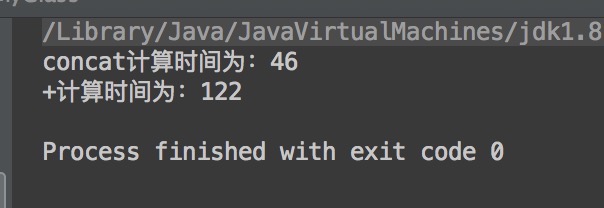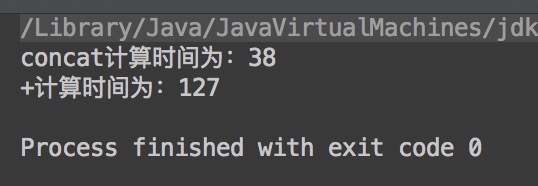String字符串拼接方法concat和+的效率对比
目录
- 两个方法效率计算代码如下
- 多次测试结果如下
- 字符串拼接 和concat的区别
两个方法效率计算代码如下
public static void main(String[] args) {
String s1 = "a";
String str1="";
String str2="";
/**
* 计算concat所用时间
*/
long str1Start = System.currentTimeMillis();
for (int i=0;i<10000;i++){
str1=str1.concat(s1);
}
long str1End = System.currentTimeMillis();
System.out.println("concat计算时间为:" + (str1End - str1Start));
/**
* 计算+所用时间
*/
long str2Start = System.currentTimeMillis();
for (int i=0;i<10000;i++){
str2=str2+s1;
}
long str2End = System.currentTimeMillis();
System.out.println("+计算时间为:" + (str2End - str2Start));
}
多次测试结果如下




经计算平均值为:
contact:45.75
+:123.75
结论为:
- concat的计算效率要比+的效率高
- concat只适用于string和string的拼接,+适用于string和任何的拼接
字符串拼接 和concat的区别
+和concat都可以用来拼接字符串,但在使用上有什么区别呢,先来看看这个例子。
public static void main(String[] args) {
// example1
String str1 = "s1";
System.out.println(str1 + 100);//s1100
System.out.println(100 + str1);//100s1
String str2 = "s2";
str2 = str2.concat("a").concat("bc");
System.out.println(str2);//s2abc
// example2
String str3 = "s3";
System.out.println(str3 + null);//s3null
System.out.println(null + str3);//nulls3
String str4 = null;
System.out.println(str4.concat("a"));//NullPointerException
System.out.println("a".concat(str4));//NullPointerException
}
concat源码:
public String concat(String str) {
int otherLen = str.length();
if (otherLen == 0) {
return this;
}
int len = value.length;
char buf[] = Arrays.copyOf(value, len + otherLen);
str.getChars(buf, len);
return new String(buf, true);
}
看下生成的字节码:
所以可以得出以下结论:
- +可以是字符串或者数字及其他基本类型数据,而concat只能接收字符串。
- +左右可以为null,concat为会空指针。
如果拼接空字符串,concat会稍快,在速度上两者可以忽略不计,如果拼接更多字符串建议用StringBuilder。
从字节码来看+号编译后就是使用了StringBuiler来拼接,所以一行+++的语句就会创建一个StringBuilder,多条+++语句就会创建多个,所以为什么建议用StringBuilder的原因。
以上为个人经验,希望能给大家一个参考,也希望大家多多支持我们。
赞 (0)

